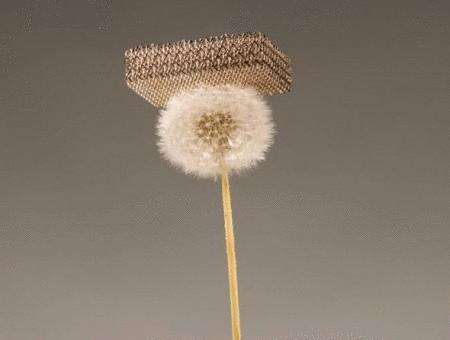The lightest metal in the world - microlitic
 Bashny.Net
Bashny.Net
A group of American scientists, which was attended by representatives of the University of California, Irvine and HRL laboratories have developed a new ultralight metal, which is dubbed microlactin (Ultralight Metallic Microlattice – ultra-light metal sponge). A hundred times lighter than Styrofoam, a piece of this metal can be put on the dandelion and totally damage it. However, do not be deceived in his account. He just seems fragile, but it can withstand enormous compared to their weight load.

The secret of this metal is in the fact that 99.99% of it does not consist of anything else than from the air. That is not even material, but rather design, in essence resembling the Golden gate bridge across the Strait of the same name in San Francisco or Paris the Eiffel tower. But if in these examples, the engineers created their works of iron beams, in this case we are talking about a series of tubes, a kind of twisted wire, the thickness of which is 1000 less than the thickness of a human hair. In addition to the incredible subtleties distinguishing feature of them is their content – these tubes are hollow inside.
Prototype made of an alloy of phosphorous and Nickel deposited on the polymeric sponge base. Thanks to these amazing qualities, it can successfully be used in almost all industries: from it you can make electrodes for batteries, used for acoustic and thermal insulation in automobile and aerospace industries for filling & shock elements and so on. Especially since, according to the creators, to make it simply, and the properties can be adjusted depending on the task. For example, by increasing the density accordingly increases and the density of the metal. Although microlactin and is the lightest metal, but the title of the lightest material he was already far, because technology does not stand still and the Technical University of Hamburg jointly with the Kiel University recently developed a carbon material on the airbrushing, the density of which is 0.2 mg/cm3 vs. 0.9 mg/cm3 of microlites. So while you read this article, perhaps in the world already there and something absolutely weightless.
Source: /users/104

The secret of this metal is in the fact that 99.99% of it does not consist of anything else than from the air. That is not even material, but rather design, in essence resembling the Golden gate bridge across the Strait of the same name in San Francisco or Paris the Eiffel tower. But if in these examples, the engineers created their works of iron beams, in this case we are talking about a series of tubes, a kind of twisted wire, the thickness of which is 1000 less than the thickness of a human hair. In addition to the incredible subtleties distinguishing feature of them is their content – these tubes are hollow inside.
Prototype made of an alloy of phosphorous and Nickel deposited on the polymeric sponge base. Thanks to these amazing qualities, it can successfully be used in almost all industries: from it you can make electrodes for batteries, used for acoustic and thermal insulation in automobile and aerospace industries for filling & shock elements and so on. Especially since, according to the creators, to make it simply, and the properties can be adjusted depending on the task. For example, by increasing the density accordingly increases and the density of the metal. Although microlactin and is the lightest metal, but the title of the lightest material he was already far, because technology does not stand still and the Technical University of Hamburg jointly with the Kiel University recently developed a carbon material on the airbrushing, the density of which is 0.2 mg/cm3 vs. 0.9 mg/cm3 of microlites. So while you read this article, perhaps in the world already there and something absolutely weightless.
Source: /users/104
Tags
science and technology
phosphorus
Nickel
the lightest metal in the world
microlites
ultralight metallic microlattice
ultra-light metal foam from the air
See also
As graphene, only phosphorus
Graphene aerogel - lightest material in the world
Made of the most delicate in the world of electronics, which can fly in the air
The easiest material
Scientists of MIT have developed ultralight solar panels outstanding to 6 watts per gram of weight
How old are you actually
Interesting facts about the unusual animals of the world
Created the fabric, which absorbs sweat and stays dry
The most idiotic questions ever asked science

















